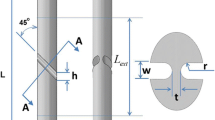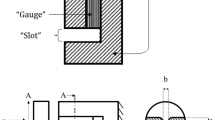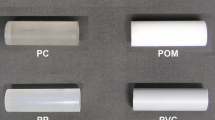Abstract
A new design of the shear compression specimen (SCS) for investigating the viscoelastic shear response of polymers is presented. The specimen consists of a polymer gage section with two metal ends that remain essentially rigid during deformation. Two closed-form analytic models are developed to predict the average stress and strain in the gage section from the deformation-load histories. This new SCS design and its analytic models are thoroughly evaluated via laboratory measurements and numerical simulations. These simulations show that the deformations in the gage section are more uniform than in the original design, and the distribution of the average shear stress and strain are highly homogenous. The simulation results yield good agreement with those of closed-form analytic results and the experiments demonstrate that the new SCS geometry and its analytic models are as reliable as other commonly employed specimens. It can also generate higher strain rates under usual loading conditions because of its smaller specimen gage length. The need for care in specimen preparation is also discussed in detail as illuminated by the experimental and simulation results.














Similar content being viewed by others
Notes
For example, OFV-551/552 Fiber-Optic Interferometer, Polytech.
To achieve this condition experimentally see reference [1].
References
Zhao J, Knauss WG, Ravichandran G (2007) Applicability of the time–temperature superposition principle in modeling dynamic response of a polyurea. Mech Time-Depend Mater 11:289–308.
Knauss WG, Zhao J (2007) Improved relaxation time coverage in ramp-strain histories. Mech Time-Depend Mater 11:199–216.
Rittel D, Lee S, Ravichandran G (2002) A shear-compression specimen for large strain testing. Experimental Mechanics 42:58–64. doi:10.1007/BF02411052.
Duffy J, Campbell JD, Hawley RH (1971) On the use of a torsional split Hopkinson bar to study rate effects in 1100 O aluminum. J Appl Mech 38:83–91.
Clifton RJ (1983) Dynamic plasticity. J Appl Mech (Trans ASME) 50:941–952.
Klepaczko JR (1994) An experimental technique for shear testing at high and very high strain rates, the case of mild steel. Int J Impact Eng 15:25–39. doi:10.1016/S0734-743X(05)80005-3.
Dorogoy A, Rittel D (2005) Numerical validation of the shear compression specimen. Part I: Quasi-static Large Strain Testing. Exp Mech 45:167–177. doi:10.1007/BF02428190.
Dorogoy A, Rittel D (2005) Numerical validation of the shear compression specimen. Part II: Dynamic large strain testing. Exp Mech 45:178–185. doi:10.1007/BF02428191.
Vural M, Rittel D, Ravichandran G (2003) Large strain mechanical behavior of 1018 cold-rolled steel over a wide range of strain rate. Metall Mater Trans A 34A:2873–2885. doi:10.1007/s11661-003-0188-8.
Lu J, Suresh S, Ravichandran G (2003) Dynamic indentation for determining the strain rate sensitivity of metals. J Mech Phys Solids 51:1923–1938. doi:10.1016/j.jmps.2003.09.007.
Lykotrafitis G, Rosakis AJ, Ravichandran G (2006) Particle velocimetry and photoelasticity applied to the study of dynamic sliding along frictionally-held bimaterial interfaces: techniques and feasibility. Exp Mech 46:205–216. doi:10.1007/s11340-006-6418-4.
Acknowledgment
We gratefully acknowledge the support of the Office of Naval Research for supporting this investigation under Grants N00014-05-1-0548 and N00014-05-1-0624. We thank Dr. R. S. Barsoum for his suggestions and discussions during the course of this research. Moreover, helpful discussions with Prof. D. Rittel, Dr. Jun Yan, Dr. X. Feng and Dr. A. Dorogoy are much appreciated. We thank the extensive contributions of Mr. Benny Poon during the experimental development.
Author information
Authors and Affiliations
Corresponding author
Rights and permissions
About this article
Cite this article
Zhao, J., Knauss, W. & Ravichandran, G. A New Shear-Compression-Specimen for Determining Quasistatic and Dynamic Polymer Properties. Exp Mech 49, 427–436 (2009). https://doi.org/10.1007/s11340-008-9171-z
Received:
Accepted:
Published:
Issue Date:
DOI: https://doi.org/10.1007/s11340-008-9171-z




